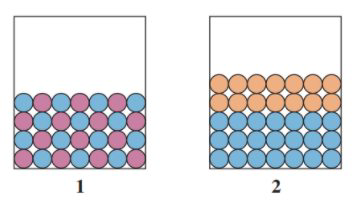
Concept explainers
The chapter sections to review are shown in parentheses at the end of each problem.
12.87 Match the diagrams with the following: (12.1)
a. a polar solute and a polar solvent
b. a nonpolar solute and a polar solvent
c. a nonpolar solute and a nonpolar solvent
 c
c
Interpretation:
The problem shows two diagrams with different type of solute-solvents.
Concept introduction:
- Like dissolves like is typically true between species
- Polar-polar solvents will always mix as well as Nonpolar-nonpolar solvents
- Nonpolar-Polar mixture will never mix, will form two phases.
To Match:The diagrams which shows the best option.
Answer to Problem 87UTC
Solution:
- 1
- 2
- 1
Explanation of Solution
There are different type of interaction between polar-polar, nonpolar-nonpolar and nonpolar-polar species. Therefore, one must ensure that the solute and solvent are well defined.
The solute is always in smaller amount than the solvent. Image (1) states an uniform mixture of species, whereas image (2) shows two phase, no mixture.
For any given mixture, there must be then either a polar-polar or a nonpolar-nonpolar solute/solvent system.
Image (2) shows the only combination possible, a nonpolar-polar mixture.
Always ensure to identify the solute, solvent and the type of interaction between them.
Want to see more full solutions like this?
Chapter 12 Solutions
Basic Chemistry
- (14.6) Which of the following aqueous solution has the highest boiling point? O 1.00 M NaCl O 1.00 M Ca(NO3)2 O 1.00 M C6H1206 O 1.00 M NaNO3arrow_forwardHow many mL of 0.39M solution contains 0.200 mol of solute? (3 SF)arrow_forward4. 3.2 g of non-volatile, nonelectrolyte solute is dissolved in 70 g of water. The resulting vapor pressure is 26.75 mmHg. If the vapor pressure of pure solvent in the condition is 28.95 mmHg and the density of the solution is 0.98 g/ml, find the following for the solution: a. osmotic pressure at 40°C b. boiling point of solution c. freezing point of solutionarrow_forward
- At 20°C, the solubility of potassium carbonate, K2CO3, is 110.3 g/100. mL of water. In the laboratory, a student mixes 215 g of K2CO3 with 175. g of H2O at a temperature of 20°C. (9.3) a) How much of the K2CO3 will dissolve? b) Is the solution saturated or unsaturated? c) What is the mass, in grams, of any solid K2CO3 left undissolved on the bottom of the container?arrow_forwardanchPad G Google O Hudl O Football Pics BIM - 1st Art 1- 2nd A WoHistory 4th AAlg2-5th A English - 6th Chem 4. 6. 7 8. 9. 10 What is the molarity of a solution containing 15.0 g of sodium hydroxide dissolved in 1.00 L of solution? Molar mass of NaOH is 40.0 grams/mole. SHOW YOUR WORK 8 10 Show Your Work 0.500 M moles 0.400 M M= 0.200 M Liter 0.374 M What is the total number of moles of NaCl(s) needed to make 1.5 liters of a 2.0 M NaCl solution? SHOW YOUR WORK 9. 10 Show Your Work 1.3 mol 5 2,269 MAY 12arrow_forward11.2 If 56.1 grams of NaCl are dissolved in 44.0 mL of Sulfuric acid, H2SO4 Sulfuric acid has a density of 1.84 grams per mL. How do I calculate the g concentration measures of: a) Weight/weight percent b) Molarityarrow_forward
- 9.44 For each of the following solutions, calculate the: a. grams of 2.0% (m/m) NaCl solution that contains 7.50 g of NaCl b. milliliters of 25% (m/v) NaF solution that contains 4.0 g of NaF c. milliliters of 8.0% (v/v) ethanol solution that contains 20.0 mL of ethanolarrow_forward9.69 Are the following solutions isotonic, hypotonic, or hypertonic compared with a red blood cell? a. distilled H,O c. 0.9% (m/v) NaCl b. 1% (m/v) glucose d. 15% (m/v) glucosearrow_forward8. 9. 10. A solution is prepared by dissolving 27.0 g urea (NH2)2CO, in 150.0 g of water. Calculate the boiling point of the solution if the Kb of water is 0.50 °C kg/mol. What mass of glycerin (C3H8O3), a nonelectrolyte, must be dissolved in 200.0 g of water to give a solution with a freezing point of -1.50 °C? The Kf for water is 1.86 °C kg/mol. A 0.500 g sample of a compound is dissolved in enough water to form 100.0 mL of solution. This solution has an osmotic pressure of 2.50 atm at 25 °C. If each molecule of the solute dissociates into two particles (in this solvent), what is the molar mass of this solute?arrow_forward
- Ammonium oxalate totally dissolves and completely ionises in water. 3.1. Write down a balanced equation for this reaction. 3.2. How many grams of ammonium thiosuphate are required to make 325ml of solution having an osmotic pressure of 675 mm Hg at 25 °C?arrow_forward%PV 1. مطلوب Q1 How many milliliters of (3 concentrated H3PO4 have 90%, density 1.881 g/cm3 are required to prepare liter of 0.4 N solution.(A.wt * .(for. H=1,P=31,0=16 g/mol 9. 7.7 6.5 7 التالي رجوع عدم إرسال كلمات المرور عبر نماذج Google مطلقًا۔ jE Ë X.University of Baghdad Jsls il pi إساءة الاستخدام Google ilai II >arrow_forwardShow your solution (Answers Given)A solution is prepared by mixing 8 g of ethanol and 50g water. Calculate a) weight % ethanol, b) molality of the solution, and c) the mole fraction of each component. (14%; 3.5m; 0.058;0.942)arrow_forward
 ChemistryChemistryISBN:9781305957404Author:Steven S. Zumdahl, Susan A. Zumdahl, Donald J. DeCostePublisher:Cengage Learning
ChemistryChemistryISBN:9781305957404Author:Steven S. Zumdahl, Susan A. Zumdahl, Donald J. DeCostePublisher:Cengage Learning ChemistryChemistryISBN:9781259911156Author:Raymond Chang Dr., Jason Overby ProfessorPublisher:McGraw-Hill Education
ChemistryChemistryISBN:9781259911156Author:Raymond Chang Dr., Jason Overby ProfessorPublisher:McGraw-Hill Education Principles of Instrumental AnalysisChemistryISBN:9781305577213Author:Douglas A. Skoog, F. James Holler, Stanley R. CrouchPublisher:Cengage Learning
Principles of Instrumental AnalysisChemistryISBN:9781305577213Author:Douglas A. Skoog, F. James Holler, Stanley R. CrouchPublisher:Cengage Learning Organic ChemistryChemistryISBN:9780078021558Author:Janice Gorzynski Smith Dr.Publisher:McGraw-Hill Education
Organic ChemistryChemistryISBN:9780078021558Author:Janice Gorzynski Smith Dr.Publisher:McGraw-Hill Education Chemistry: Principles and ReactionsChemistryISBN:9781305079373Author:William L. Masterton, Cecile N. HurleyPublisher:Cengage Learning
Chemistry: Principles and ReactionsChemistryISBN:9781305079373Author:William L. Masterton, Cecile N. HurleyPublisher:Cengage Learning Elementary Principles of Chemical Processes, Bind...ChemistryISBN:9781118431221Author:Richard M. Felder, Ronald W. Rousseau, Lisa G. BullardPublisher:WILEY
Elementary Principles of Chemical Processes, Bind...ChemistryISBN:9781118431221Author:Richard M. Felder, Ronald W. Rousseau, Lisa G. BullardPublisher:WILEY





